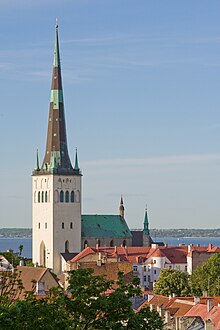
Back Estoniyada din Azerbaijani Рэлігія ў Эстоніі Byelorussian Рэлігія ў Эстоніі BE-X-OLD Θρησκεία στην Εσθονία Greek Religión en Estonia Spanish Religioon Eestis Estonian Uskonto Virossa Finnish Religion en Estonie French Religija u Estoniji Croatian Կրոնն Էստոնիայում Armenian
Religion in Estonia (2021)[1]

Estonia, historically a Lutheran Christian nation,[2][3][4] is today one of the "least religious" countries in the world in terms of declared attitudes, with only 14 percent of the population declaring religion to be an important part of their daily life.[5] This is thought to largely be a result of the Soviet occupation of Estonia in 1940,[citation needed] prior to which Estonia had a large Christian majority.
The religious population is predominantly Christian and includes followers of 90 affiliations. According to the Estonian Council of Churches data from December 2019, 13.8 percent of the population belong to the Estonian Evangelical Lutheran Church, while 13.1 percent belong to the Estonian Orthodox Church of Moscow Patriarchate (EOCMP), and 2.3 percent belong to the Estonian Apostolic Orthodox Church. The Union of Free Evangelical and Baptist Churches of Estonia and the Roman Catholic Church in Estonia together comprise 1 percent of the population. Other Christian groups, including Jehovah’s Witnesses, Pentecostals, Methodists, Seventh-day Adventists, and Russian Old Believers, collectively constitute 1.1 percent of the population.[6] According to Ringo Ringvee, "religion has never played an important role on the political or ideological battlefield" and the "tendencies that prevailed in the late 1930s for closer relations between the state and Lutheran church were ended with the Soviet occupation in 1940". He further states that "the chain of religious traditions was broken in most families" under the Soviet policy of state atheism.[3][7] Before the Second World War, Estonia was approximately 80 per cent Protestant; overwhelmingly Lutheran, partly because of historic Swedish rule. Under Russian and Soviet rule, this predominance greatly decreased, while Eastern Orthodoxy increased due to immigration of Russians.
Between 2001 and 2011 census, Eastern Orthodoxy overtook Lutheranism to become the largest Christian denomination in the country due to increasing lack of affiliation and very few conversions among Estonians, as well as due to steady or even increased religious affiliation among the Russian-speaking minorities. Lutheranism still remains the most popular religious group among ethnic Estonians (11 percent of them are Lutherans while also 2 percent of them are Orthodox), while Eastern Orthodoxy is practised mainly by the mostly non-indigenous Slavic minorities (approximately 45 per cent of them are Orthodox). According to the University of Tartu, irreligious Estonians are not necessarily atheists; instead, the 2010s have witnessed a growth of Neopagan, Buddhist and Hindu beliefs among those who declare themselves to be "not religious".[8]
- ^ Cite error: The named reference
Censuswas invoked but never defined (see the help page). - ^ Ivković, Sanja Kutnjak; Haberfeld, M.R. (10 June 2015). Measuring Police Integrity Across the World: Studies from Established Democracies and Countries in Transition. Springer. p. 131. ISBN 9781493922796.
Estonia is considered Protestant when classified by its historically predominant major religion (Norris and Inglehart 2011) and thus some authors (e.g., Davie 2003) claim Estonia belongs to Western (Lutheran) Europe, while others (e.g., Norris and Inglehart 2011) see Estonia as a Protestant ex-Communist society.
- ^ a b Cite error: The named reference
MarshallCavendish2010was invoked but never defined (see the help page). - ^ Rausing, Sigrid (2004). History, Memory, and Identity in Post-Soviet Estonia: The End of a Collective Farm. Oxford University Press. p. 96. ISBN 9780199263189.
Protestantism has done much to inform the moral world view of the Estonians, particularly the process of distinguishing themselves from the Russians.
- ^ "Estonians least religious in the world". EU Observer. 11 February 2009. Retrieved 9 January 2014.
- ^ Office of International Religious Freedom, 2020 Report on International Religious Freedom: Estonia, United States Department of State
- ^ Ringvee, Ringo (16 September 2011). "Is Estonia really the least religious country in the world?". The Guardian.
For this situation there are several reasons, starting from the distant past (the close connection of the churches with the Swedish or German ruling classes) up to the Soviet-period atheist policy when the chain of religious traditions was broken in most families. In Estonia, religion has never played an important role on the political or ideological battlefield. The institutional religious life was dominated by foreigners until the early 20th century. The tendencies that prevailed in the late 1930s for closer relations between the state and Lutheran church [...] ended with the Soviet occupation in 1940.
- ^ Martin Noorkõiv (6 November 2012). "The Estonian Atheist Experiment". University of Tartu Blog.
© MMXXIII Rich X Search. We shall prevail. All rights reserved. Rich X Search